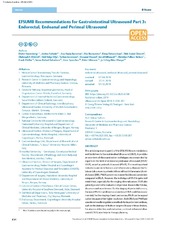| dc.contributor.author | Nürnberg, Dieter | en_US |
| dc.contributor.author | Saftoiu, Adrian | en_US |
| dc.contributor.author | Barreiros, Ana Paula | en_US |
| dc.contributor.author | Burmester, Eike | en_US |
| dc.contributor.author | Ivan, Elena Tatiana | en_US |
| dc.contributor.author | Clevert, Dirk-André | en_US |
| dc.contributor.author | Dietrich, Christoph F. | en_US |
| dc.contributor.author | Gilja, Odd Helge | en_US |
| dc.contributor.author | Lorentzen, Torben | en_US |
| dc.contributor.author | Maconi, Giovanni | en_US |
| dc.contributor.author | Mihmanli, Ismail | en_US |
| dc.contributor.author | Nolsøe, Christian Pállson | en_US |
| dc.contributor.author | Pfeffer, Frank | en_US |
| dc.contributor.author | Rafaelsen, Søren Rafael | en_US |
| dc.contributor.author | Spârchez, Zeno | en_US |
| dc.contributor.author | Vilmann, Peter | en_US |
| dc.contributor.author | Waage, Jo Erling Riise | en_US |
| dc.date.accessioned | 2020-08-05T10:27:25Z | |
| dc.date.available | 2020-08-05T10:27:25Z | |
| dc.date.issued | 2019 | |
| dc.Published | Nürnberg D, Saftoiu A, Barreiros, Burmester E, Ivan, Clevert D, Dietrich CF, Gilja OH, Lorentzen T, Maconi G, Mihmanli I, Nolsøe CP, Pfeffer F, Rafaelsen, Spârchez Z, Vilmann P, Waage JER. EFSUMB recommendations for gastrointestinal ultrasound part 3: Endorectal, endoanal and perineal ultrasound. Ultrasound International Open. 2019;5(1):E34-E51 | eng |
| dc.identifier.issn | 2199-7152 | |
| dc.identifier.uri | https://hdl.handle.net/1956/23446 | |
| dc.description.abstract | This article represents part 3 of the EFSUMB Recommendations and Guidelines for Gastrointestinal Ultrasound (GIUS). It provides an overview of the examination techniques recommended by experts in the field of endorectal/endoanal ultrasound (ERUS/EAUS), as well as perineal ultrasound (PNUS). The most important indications are rectal tumors and inflammatory diseases like fistula and abscesses in patients with or without inflammatory bowel disease (IBD). PNUS sometimes is more flexible and convenient compared to ERUS. However, the technique of ERUS is quite well established, especially for the staging of rectal cancer. EAUS also gained ground in the evaluation of perianal diseases like fistulas, abscesses and incontinence. For the staging of perirectal tumors, the use of PNUS in addition to conventional ERUS could be recommended. For the staging of anal carcinomas, PNUS can be a good option because of the higher resolution. Both ERUS and PNUS are considered excellent guidance methods for invasive interventions, such as the drainage of fluids or targeted biopsy of tissue lesions. For abscess detection and evaluation, contrast-enhanced ultrasound (CEUS) also helps in therapy planning. | en_US |
| dc.language.iso | eng | eng |
| dc.publisher | Thieme | eng |
| dc.rights | Attribution-Non Commercial-No Derivatives CC BY-NC-ND | eng |
| dc.rights.uri | http://creativecommons.org/licenses/by-nc-nd/4.0/ | eng |
| dc.title | EFSUMB recommendations for gastrointestinal ultrasound part 3: Endorectal, endoanal and perineal ultrasound | en_US |
| dc.type | Peer reviewed | |
| dc.type | Journal article | |
| dc.date.updated | 2020-02-11T11:46:50Z | |
| dc.description.version | publishedVersion | en_US |
| dc.rights.holder | Copyright Georg Thieme Verlag | |
| dc.identifier.doi | https://doi.org/10.1055/a-0825-6708 | |
| dc.identifier.cristin | 1772873 | |
| dc.source.journal | Ultrasound International Open | |

